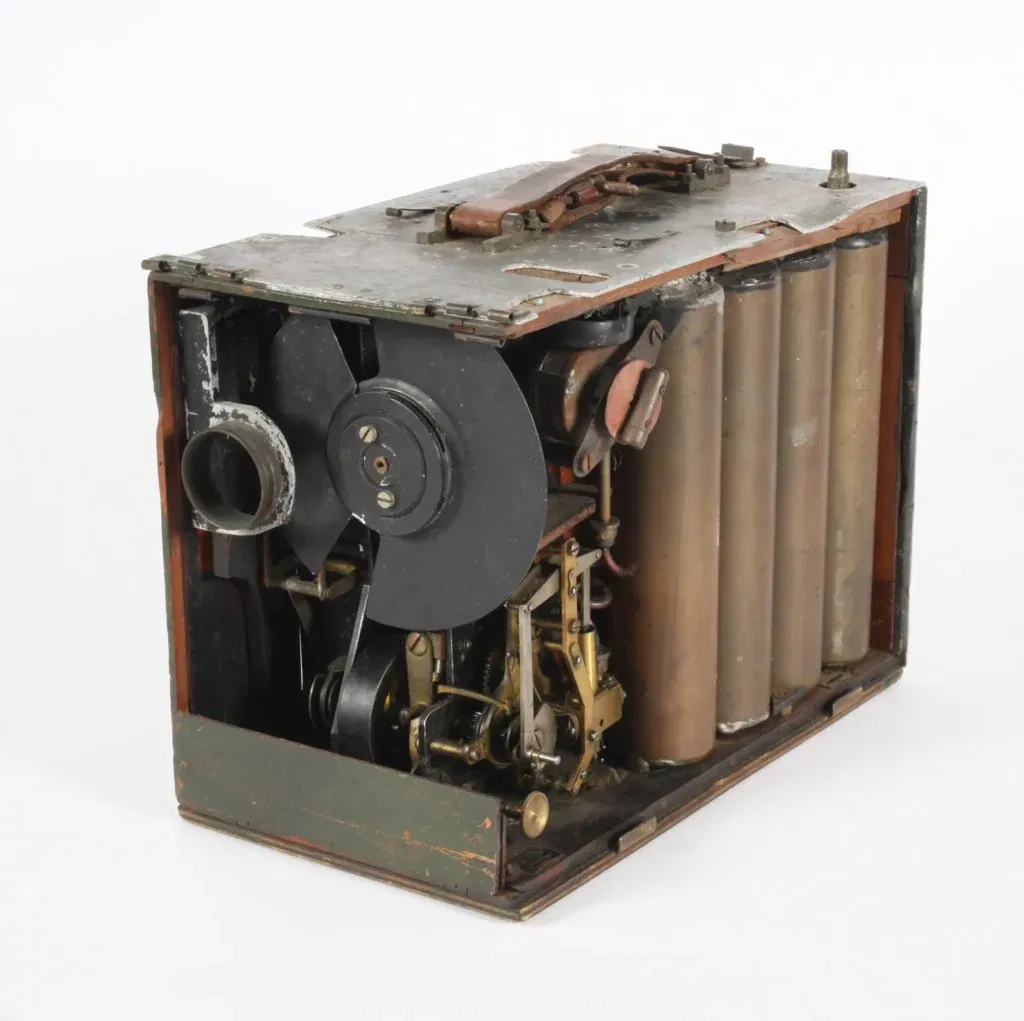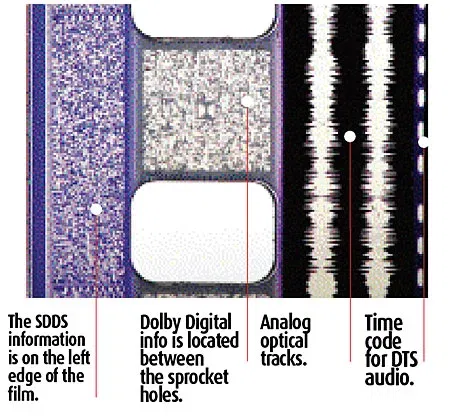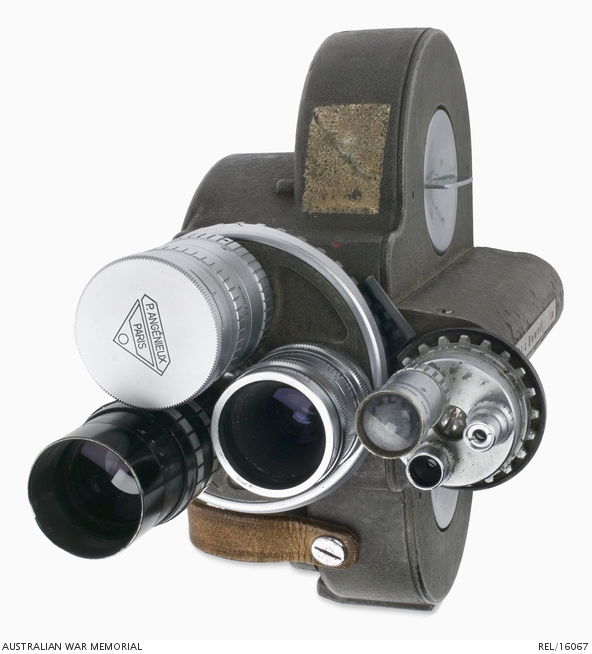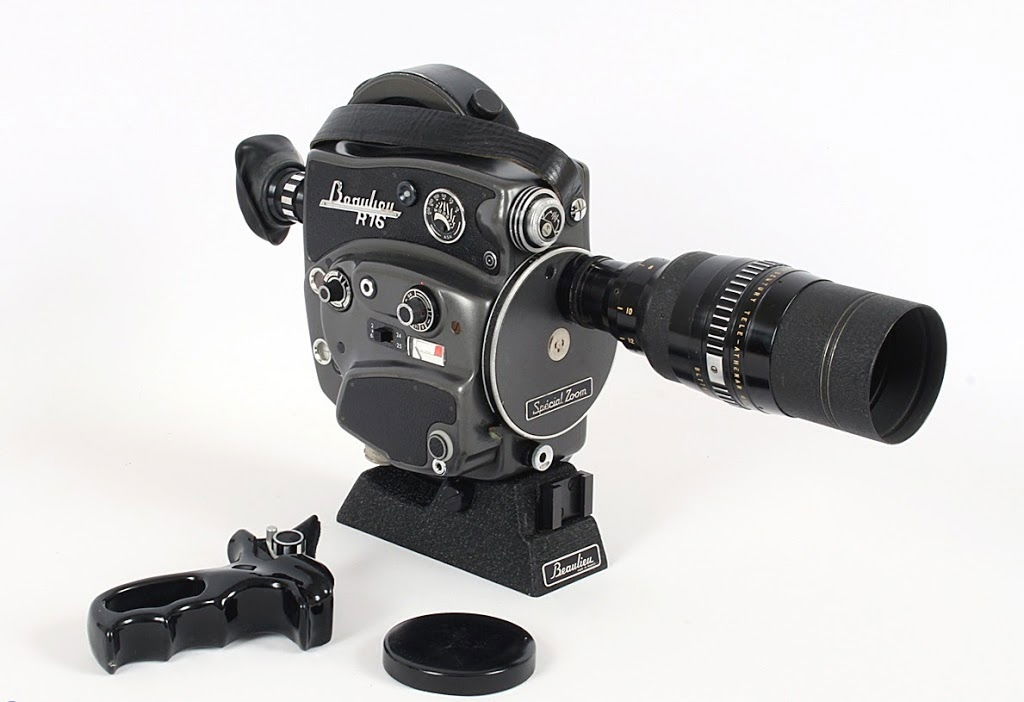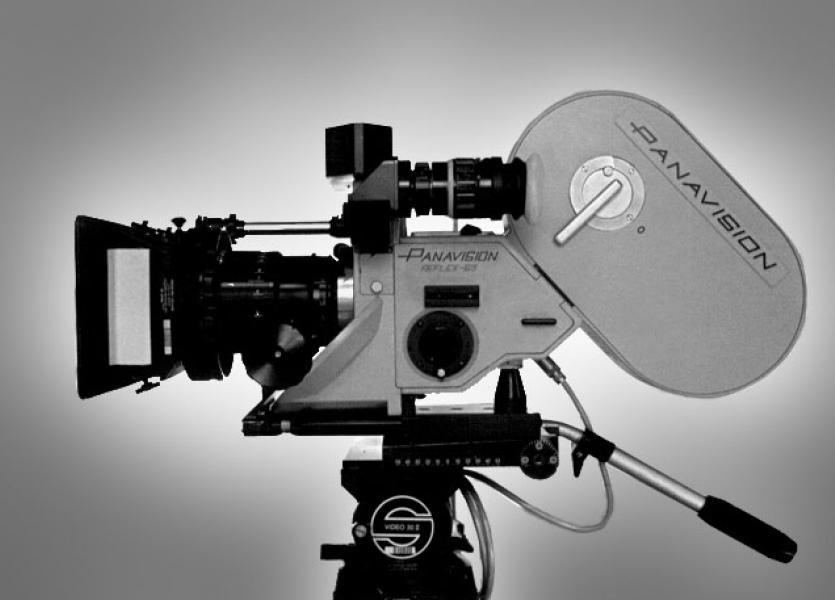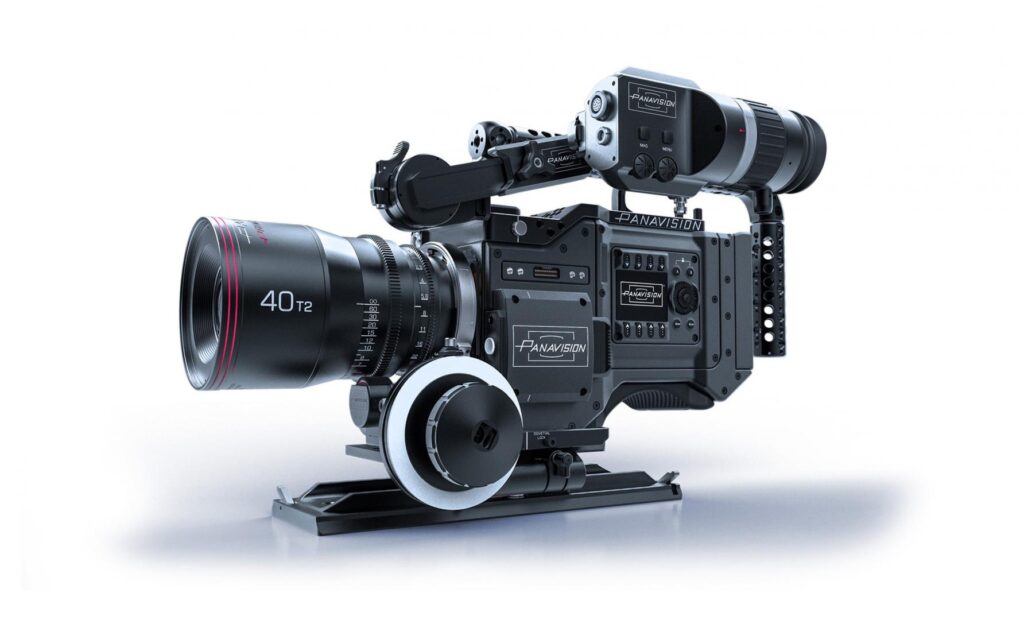Few technological journeys capture the imagination quite like the camera evolution in motion pictures. From the first tentative attempts to capture movement in the late 1800s to today’s sophisticated digital cinema systems, this remarkable story spans nearly two centuries of human innovation. What began with simple hand-cranked devices, capable of recording only seconds of grainy footage, has transformed into technology that can create entire worlds on screen.
The impact of this evolution extends far beyond the technical specifications of frame rates and resolutions. Motion picture cameras haven’t just changed how we record images – they’ve fundamentally transformed how we tell stories, share experiences, and see our world. Each breakthrough, from the introduction of synchronized sound to the emergence of color film, from portable cameras to digital sensors, has expanded the possibilities of visual storytelling. Today’s cinematographers work with tools that early pioneers could only dream of: cameras that can capture stunning 8K resolution, record in almost complete darkness, and seamlessly integrate with virtual environments. Yet despite all this technological sophistication, they serve the same fundamental purpose as those first primitive devices – bringing stories to life through moving images.
Table of Contents
Early Camera Pioneers and Inventions
Camera evolution began long before the first motion picture flickered across a screen. In the early 19th century, inventors and artists were already exploring ways to capture and recreate movement, laying the groundwork for what would become cinematography.
Pre-Cinema Optical Devices
The camera obscura, a darkened room or box with a small opening that projected inverted images, provided the first glimpse into how light could create images. But the real breakthrough in camera evolution came from understanding how human vision processes movement.
In the 1830s, a series of ingenious devices emerged that would fundamentally shape the future of motion pictures. The Phenakistiscope, invented by Joseph Plateau in 1832, used a spinning disk decorated with sequential images and viewed through precisely-spaced slits. When rotated in front of a mirror, it created the world’s first artificial animation.
William Horner’s Zoetrope, introduced in 1834, took this concept further. This cylindrical device could entertain multiple viewers simultaneously, making it the first shared motion picture experience. These early optical innovations demonstrated a crucial principle: when images change quickly enough, our brains perceive continuous motion rather than individual frames.
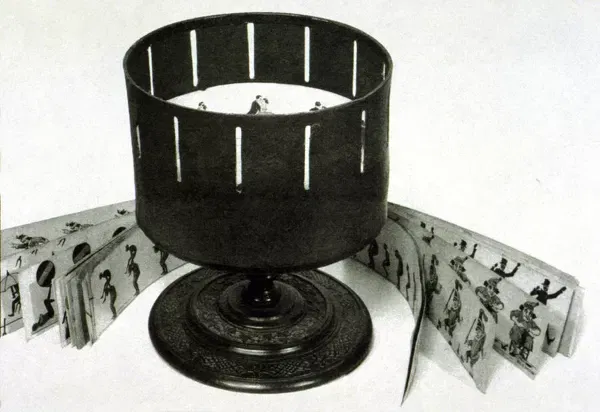
First Motion Picture Cameras
The true genesis of cinema came with the invention of devices that could actually record movement. Étienne-Jules Marey’s Chronophotographic Gun (1882) marked a pivotal moment in camera evolution. This remarkable device could capture 12 frames per second of actual motion, not just create the illusion of it.
However, it was Thomas Edison and William Dickson’s Kinetograph in 1891 that truly revolutionized motion picture technology. Their innovations included:
- Perforated celluloid film strips for precise movement
- An ingenious sprocket system ensuring smooth film transport
- Continuous recording capability
- A standardized frame rate of 40 frames per second
Key Inventors and Their Contributions
The late 19th century saw several pioneers whose work proved crucial to camera evolution:
| Inventor | Yerar | Innovation | Historical Impact |
| Eadweard Muybridge | 1878 | Sequential Photography | First proved the exact motion of a galloping horse, settling a long-standing debate |
| Louis Le Prince | 1888 | Single-lens Camera | Created the first true motion recordings, though tragically disappeared before sharing his work widely |
| Auguste & Louis Lumière | 1895 | Cinématographe | Revolutionized filmmaking with their all-in-one camera, printer, and projector |
The first motion picture camera was originally invented by French inventor Léon Bouly on February 12, 1892, but Bouly could not maintain the patent cost, which allowed The Lumière brothers’ to release the Cinématographe in 1895. More compact than Edison’s Kinetograph, this versatile device served as camera, printer, and projector. Its clever intermittent movement mechanism, inspired by sewing machine technology, moved film at 16 frames per second – creating smoother motion than previous attempts.
These early pioneers did more than just invent new devices; they established the fundamental principles of motion picture cameras that we still use today. Their work with intermittent motion, shuttering systems, and film transport mechanisms created the blueprint that would guide camera technology for the next century and beyond.

Fundamental Camera Mechanisms
The evolution of cameras hinged on three revolutionary systems that made modern cinema possible. These core mechanisms represent a crucial phase in camera evolution, shaping how cameras would develop for generations to come, influencing even today’s digital cinematography.
Film Transport Systems
At the heart of early motion picture cameras lay the crucial film transport mechanism. What began as simple hand-cranked systems eventually evolved into sophisticated electronic controls, but the real breakthrough came with the intermittent movement mechanism.
This ingenious device solved one of cinematography’s biggest challenges: how to position each frame precisely for exposure. Using either a Geneva drive or pin-registration method, the system could:
- Advance the film frame by frame with perfect precision
- Hold each frame completely still during exposure
- Maintain consistent spacing between frames
- Prevent film damage during movement

The innovation worked by precisely moving the celluloid film frame by frame while maintaining perfect alignment. Sprocket wheels, engaging with perforations in the film, ensured smooth and reliable transport without damaging the delicate film stock.
Modern cameras evolved to incorporate various movement types:
- Cam-driven systems (used in early Arriflex models)
- Seven-link movements (introduced in later Arriflex designs)
- Five-link movements (found in advanced high-speed cameras)
- Magnetic drive wheels (pioneered by Aaton)
These sophisticated transport systems could achieve remarkable frame rates, from as low as 1 frame per second to over 150 frames per second in some high-speed cameras.
Shutter Mechanisms
The development of the rotary disc shutter marked another crucial leap in motion picture technology. Most professional cameras adopted either the half-moon (180°) design or the butterfly shutter with two opposing 90° segments.

Half-Moon Design
- 180-degree rotating disc
- Single-blade configuration
- Excellent for standard frame rates
- Common in many professional cameras
Butterfly Design
- Dual opposing blades
- Typically 90-degrees each
- Rotates at half-speed
- Superior balance at high speeds
Professional cinema benefited greatly from the focal-plane shutter. It allowed precise exposure control and helped develop interchangeable lens systems. These shutters worked together with timing mechanisms – first mechanical, then electronic – to provide better exposure control.
Modern shutter systems featured sophisticated electronic controls offering:
- Precise angle adjustment (from 11.2° to 200°)
- Electronic synchronization
- Variable speed control
- Smooth ramping capabilities
The development of crystal-controlled motors in the 1970s brought unprecedented precision to shutter timing. This innovation enabled:
- Perfect sync sound recording
- Consistent exposure across frames
- Reliable slow-motion capture
- Precise special effects work
Lens Technology Development
The evolution of lens technology dramatically expanded what cinematographers could achieve. Several breakthrough innovations transformed the field:
- Introduction of anastigmat lenses improving image quality
- Development of zoom lenses enabling dynamic shot composition
- Integration of coating technologies reducing lens flare
- Implementation of aspherical elements enhancing optical performance
Perhaps the most significant advancement came with coated optics. This technology dramatically reduced reflections and maximized light transmission, helping cinematographers achieve that distinctive “filmic look” that became crucial for storytelling. Modern digital cinema continues to build on these optical innovations, allowing different productions to create their unique visual signatures.

Technical Innovations of the Silent Era
The silent era marked a defining period in camera evolution. Between 1895 and 1927, motion picture cameras transformed from basic recording devices into sophisticated instruments of visual storytelling. During this time, pioneering inventors and cinematographers pushed the boundaries of what cameras could achieve, laying the foundation for modern filmmaking technology. New capabilities emerged in mobility, film formats, and lighting techniques.
Camera Mobility Advances
Until 1907, cameras remained largely static – fixed observers of the action before them. Everything changed with the introduction of wooden dolly tracks, a simple innovation that revolutionized cinematography. For the first time, cameras could glide smoothly through space, becoming active participants in storytelling.
The real breakthrough came in the 1940s with the Chapman-Leonard crane. This remarkable piece of engineering gave cinematographers capabilities that would seem familiar even to modern filmmakers:
- Hydraulic lift mechanisms
- 360-degree rotation capability
- Counterbalanced boom arms
- Silent operation for indoor shooting

Film Format Development
While 35mm film became the industry standard, the evolution of cameras didn’t stop there. Cinematographers began experimenting with larger formats that could capture more detail and create more immersive experiences:
| Format | Image Area | Usage |
| Standard 8mm | Entry-level format. 1.36:1 aspect ratio | Home movies, amateur use |
| Super 8mm | 50% larger than standard 8mm. 1.45:1 aspect ratio | Advanced amateur filmmaking |
| Standard 16mm | Original amateur format. 1.37:1 aspect ratio | Industrial, educational films |
| Super 16mm | 40% larger than standard 16mm. 1.66:1 aspect ratio | Professional productions, documentaries |
| 35mm 2-perf | 50% more shooting time. 2.39:1 aspect ratio | Limited budget productions |
| 35mm 3-perf (Super 35) | 25% less film usage. 1.78:1 aspect ratio | Television and digital intermediate |
| 35mm 4-perf (Standard 35) | Standard frame height. 1.33:1 aspect ratio | Traditional productions |
| VistaVision 8-perf (Full Frame) | Horizontal 35mm format. 1.5:1 aspect ratio | High resolution, Visual Effects work |
| Anamorphic (or Cinemascope) | Squeezed widescreen image. 2.39:1 aspect ratio | Epic wide-screen cinematography |
| Standard 65mm (5/70) known as Todd-AO or Super Panavision | 65mm negative/70mm print. 2.2:1 aspect ratio | Premium theatrical releases |
| Ultra Panavision 70 (MGM Camera 65) | 65mm with 1.25x anamorphic. 2.76:1 aspect ratio | Specialized large format productions |
| Dynavision (8/70) | 70mm camera original. 1.4:1 aspect ratio | Ultra-wide epic productions |
| IMAX (15/70) | 10x larger. 1.35:1 aspect ratio | Specialized filming |
Each format advance brought new challenges. The larger the film, the more substantial the camera became. A 1000-foot reel of 70mm film could only capture three minutes of action, compared to eleven minutes with standard 35mm.
Lighting Integration
The evolution of cameras in the silent era was profoundly influenced by advances in lighting technology. The journey with the Jablochkoff “electric candle” system in 1878 marking the birth of professional film lighting. This technology evolved into mobile lighting units that could be positioned for dramatic effect.
Initially, early motion pictures relied entirely on daylight, restricting filming to outdoor locations or specially constructed glass-roofed studios. With early film stocks estimated to be rated at approximately 2-3 ASA (now ISO), cinematographers needed enormous amounts of light for proper exposure. The introduction of carbon-arc lamps in the late 1910s transformed indoor cinematography by providing the intense illumination needed to expose these slow-speed films. These lights could produce up to 50,000 lumens of crisp, daylight-balanced light that could properly expose even the most light-hungry film stocks of the era.
- Directors could now film indoors regardless of weather or time of day
- Cinematographers gained precise control over shadows and depth
- Exposure became consistent and predictable
- Creative lighting effects became possible

The Rise of Professional Cinema Cameras
When Hollywood began to find its rhythm, camera evolution entered a new phase in the early 1900s, something remarkable happened – the standardization of professional cinema cameras. This wasn’t just a technical milestone; it marked the moment when filmmaking transformed from a novelty into an art form that would captivate audiences worldwide.
35mm Standard Establishment
The story of 35mm film’s dominance begins with Thomas Edison, but it’s really a tale of practical innovation winning out over competing formats. Early filmmakers faced a chaotic landscape of different film sizes and standards, but 35mm emerged as the sweet spot – wide enough for impressive image quality, yet economical enough for practical production.
The format took hold because it simply worked better than anything else available:
- Studios could share equipment and facilities
- Theaters could show films from any producer
- Film labs could standardize their processes
- Camera manufacturers could focus on innovation rather than format wars
Studio Camera Systems
In 1919, a small company called Mitchell Camera Corporation changed everything. Their cameras weren’t just tools; they were precision instruments that gave cinematographers unprecedented control over their craft. The Mitchell Model A, designed by the brilliant John E. Leonard, brought features that modern cinematographers now take for granted:
- Ground-glass focusing that finally let cinematographers see exactly what they were shooting
- A four-lens turret that made lens changes as simple as a quick rotation
- A revolutionary 170° shutter that gave improved exposure control
- Pin-registration so precise that images stayed rock-steady frame after frame
But Mitchell’s real masterpiece came in 1934 – the BNC (Blimped Noiseless Camera). This was the camera that shot “Citizen Kane,” helped define film noir, and became the gold standard for Hollywood cinematography for over three decades.

Sound Integration Challenges
Sound brought new challenges to camera design. Camera noise had to be eliminated while keeping operations efficient. “Blimping” – encasing cameras in soundproof housings – provided the solution. The Mitchell NC (News Camera) brought a revolutionary NC Eccentric movement in 1932, with four claws and two pointer pins moving on an eccentric axis.
Sound recording equipment needed major changes to existing camera systems. New synchronization innovations emerged:
- Single-system news film cameras with optical recording heads
- Double-system recording for enhanced sound quality
- Precision audio devices for separate sound capture
- Motors had to maintain exact speeds and stay perfectly in sync with new audio recordings systems
These developments changed how films were made. Crews grew larger, equipment became more sophisticated, and the entire process of filmmaking became more complex. But the results were worth it – for the first time, audiences could see and hear stories unfold with a realism that was previously impossible.
Colour and Sound Revolution
Camera evolution reached a pivotal moment in the late 1920s and early 1930s when two revolutionary technologies converged: colour and sound. This convergence forever changed how motion picture cameras were designed and operated, ushering in a new era of cinematographic complexity and artistic possibility.
Technicolor Camera Systems
The arrival of Technicolor’s three-strip camera in 1932 marked a watershed moment in the evolution of motion picture technology. These remarkable machines, built by Mitchell Camera Corporation to exacting specifications, represented the pinnacle of precision engineering in their era. Weighing over 500 pounds when fully loaded, they were essentially three cameras in one, utilizing an ingenious beam-splitter system that would define Hollywood’s visual aesthetic for decades.
At the heart of the system lay a sophisticated prism that separated light into three distinct paths, each exposing a separate strip of black and white film through precisely calibrated color filters. The engineering tolerance was staggering – even a misalignment of one ten-thousandth of an inch could ruin the color registration. Such was the complexity of these machines that only about 30 were ever built, making them among the most exclusive pieces of cinema equipment ever created.
Operating these cameras demanded extraordinary technical expertise. Cinematographers had to maintain perfect synchronization between multiple film strips while working with a system that absorbed nearly 75% of the incoming light. Loading the camera alone was a delicate operation that took skilled technicians up to 45 minutes, requiring precise threading of three separate film paths while working in near-total darkness.
The demands on lighting were equally formidable. Technicolor productions required between 350-450 foot-candles of light for proper exposure – roughly ten times what black and white filming needed. This necessitated powerful carbon arc lamps that dominated sets, generating so much heat that special cooling systems became mandatory. Technicians constantly monitored color temperature, as even slight variations could compromise the entire system’s color accuracy.
By the late 1930s, Technicolor’s engineers had refined their system considerably, improving film transport mechanisms and prism design to reduce setup times and enhance colour accuracy. Despite its challenges, this complex system produced images of unprecedented beauty, establishing color standards that would influence cinematography for generations to come.
Sound Recording Integration
The integration of sound recording in the late 1920s fundamentally transformed motion picture camera design. As the industry transitioned from silent film, engineers faced a crucial challenge: how to capture pristine sound while dealing with mechanically noisy cameras. The solution came through optical sound recording, where audio was converted into patterns of light and captured directly onto film alongside the image.
Western Electric pioneered this technology with their revolutionary sound-on-film system. Audio was captured by microphones, converted to electrical signals, and then transformed into variations of light intensity by a specialized galvanometer. This modulated light was recorded onto the film’s soundtrack area, creating either variable-density or variable-area patterns that could be read back during projection.
The technical demands were extraordinary. Cameras needed sophisticated soundproofing to prevent their mechanical noise from reaching the microphones. The film had to move through the camera with absolute consistency – any speed variation would affect the sound pitch. This led to the development of precision motors with exact speed control, replacing the hand-cranked mechanisms of the silent era.
RCA offered a competing system, but Western Electric’s variable-area method proved superior for both recording and reproduction. Their system could achieve broader dynamic range and better noise reduction while maintaining compatibility with existing projection equipment. The familiar soundtrack pattern visible on film – a jagged waveform along the edge – comes from this Western Electric design.
By the mid-1930s, these innovations had evolved into sophisticated recording techniques that could capture remarkably high-fidelity sound. The introduction of push-pull recording and noise reduction systems further improved quality, while specialized monitoring equipment helped sound technicians maintain precise calibration. These developments set standards that would influence sound recording technology for decades to come.
Multi-Format Capabilities
The merger of color and sound created huge challenges for cinematographers in the 1930s. Imagine trying to The emergence of different film formats in the 1930s and 1940s presented significant engineering challenges for camera manufacturers. While today’s digital cameras can switch formats with the push of a button, early motion picture cameras required extensive mechanical modification to handle different film sizes and formats.
Mitchell Camera Corporation pioneered early attempts at format adaptability with their NC (News Camera) in the early 1940s. The camera could be modified to handle different 35mm formats, but the conversion process was far from simple. Each change required precise mechanical adjustments and often days of downtime for recalibration. The practical reality meant most studios maintained separate cameras for different formats rather than attempting conversions.
The challenge of maintaining perfect film registration – keeping frames absolutely steady during exposure – became even more complex when cameras were modified for different formats. Engineers had to devise new solutions for film transport and registration systems that could maintain precision across multiple format sizes. Even small inconsistencies in registration could render footage unusable, particularly for visual effects work.
These technical hurdles ultimately pushed camera evolution in an unexpected direction. Rather than pursuing truly adaptable cameras, manufacturers focused on developing specialized systems optimized for specific formats. This approach led to better results and helped establish the distinct production workflows that would define professional cinematography for decades to come.
Portable Camera Development
Camera evolution took a dramatic turn in 1923 when the dream of truly portable filmmaking became reality. No longer tethered to studio floors or confined by bulky equipment, cinematographers could finally move with the freedom their creative visions demanded.
16mm Format Introduction
When Eastman Kodak introduced their 16mm format, they didn’t just launch a new product – they sparked a democratic revolution in filmmaking. The CINE-KODAK camera and KODASCOPE projector package, priced at $335 (about $6,000 today), suddenly made motion picture photography accessible to a new generation of filmmakers.


The format’s innovations were transformative:
- Safety film base eliminated the fire hazards of nitrate stock
- Direct reversal processing meant no separate negative was needed
- Compact design allowed true portability for the first time
- Lower costs opened filmmaking to non-professionals
Documentary Camera Evolution
The real game-changer arrived in 1937 with the Arriflex 35. This remarkable camera introduced the revolutionary reflex viewing system – a spinning mirror shutter that let cinematographers see exactly what they were filming through the taking lens. For documentary filmmakers, this meant:
- No more parallax errors in framing
- Precise focus even with long lenses
- Ability to follow fast-moving action
- Accurate composition in rapidly changing situations
Post-World War II technological advances further transformed portable filmmaking:
- Crystal sync sound capabilities
- Better movement mechanisms
- Superior optical systems
- Advanced shutter designs
Mobile Camera Innovation
The impact of the Steadicam on cinematography was revolutionary and immediate. The system allowed operators to achieve what seemed impossible shots: combining the organic, fluid movement of handheld operation with the smooth precision of dolly shots. This innovation sparked the development of numerous camera stabilising systems, each pushing the boundaries of what cinematographers could achieve.
Camera mobility reached a defining moment in the early 1970s when cinematographer Garrett Brown introduced the Steadicam. This stabilization system transformed motion picture photography, making its debut in Hal Ashby’s “Bound for Glory” before its use in “Rocky” and Kubrick’s “The Shining.”

That same era saw another breakthrough with the arrival of self-blimped cameras in 1972. These cameras solved the persistent challenge of camera noise that had plagued sound recording since the advent of “talkies.” By eliminating the need for bulky external sound blimps, camera weights plummeted from an unwieldy 122 pounds to a manageable 13 pounds, while maintaining pristine sound quality.
The Best Film Cameras ever Made
As camera evolution approached the digital transition, the motion picture industry witnessed the creation of what many consider the finest film cameras ever manufactured. These remarkable machines, developed during the 1990s and early 2000s, represented the pinnacle of mechanical and optical engineering in cinema technology. Four manufacturers – ARRI, Panavision, Aaton, and Moviecam – pushed the boundaries of what was possible with analog technology, creating cameras that combined precise mechanical engineering with sophisticated electronics.
These cameras weren’t just technical achievements; they were the culmination of nearly a century of camera evolution, incorporating everything cinematographers had learned about their craft. Each manufacturer brought their unique philosophy to camera design, resulting in distinct approaches to solving the fundamental challenges of motion picture photography. Even today, as digital technology dominates the industry, these cameras remain benchmarks against which modern systems are measured.
ARRI
ARRI’s dominance in film camera evolution culminated in four revolutionary designs. The 435 series redefined high-speed cinematography with its ability to shoot up to 150 frames per second while maintaining perfect image stability. Its sophisticated five-link movement and versatile electronic control system made it the go-to camera for special effects work on blockbusters like “The Matrix” and “Lord of the Rings.”
The Arricam system, introduced in 2000, represented the absolute pinnacle of film camera design. The studio-oriented ST and lightweight LT models combined ultra-quiet operation with unprecedented modularity. These cameras featured integrated wireless remote control, sophisticated electronic viewfinders, and the industry’s most advanced lens data system. The lightweight 235 model completed the lineup, bringing ARRI’s precision to compact filming situations.
Panavision
Panavision’s Millennium XL2 emerged as the most refined motion picture camera of the film era. Its innovative design solved persistent challenges that had plagued cinematographers for decades. The camera’s movement was so quiet it could shoot within feet of microphones without additional sound dampening, while its compact form factor made it exceptionally versatile for both studio and location work.
Their System 65 cameras rewrote the rules for large-format cinematography. Designed specifically for 65mm film, these cameras produced images of extraordinary clarity and detail. The system’s precision engineering and robust construction made it reliable enough for challenging productions like “The Hateful Eight,” where Panavision restored and rebuilt vintage Ultra Panavision 70 cameras to capture Quentin Tarantino’s epic western in rare 70mm format.
Aaton
Aaton’s approach to camera design was uniquely influenced by founder Jean-Pierre Beauviala’s philosophy that cameras should rest on an operator’s shoulder “like a cat.” The Penelope, their masterpiece of analog technology, embodied this ideology perfectly. Its distinctive design featured an asymmetrical body that naturally balanced on the shoulder, while its 2-perf and 3-perf compatibility offered unprecedented economy in film consumption.
The camera’s extraordinarily quiet operation – achieved without traditional blimping – made it ideal for intimate documentary situations, while its precision mechanics and superior optics satisfied the demands of feature production. Penelope’s design influenced camera ergonomics across the industry, proving that technical excellence and user comfort could coexist.

Moviecam
Moviecam brought Austrian precision to motion picture cameras, with their Compact mk2 and SL mk2 models representing the height of mechanical refinement. The Compact mk2 became legendary for its reliability in extreme conditions, from arctic documentaries to desert warfare epics. Its exceptional optical viewfinder system and rock-steady movement made it a favorite among operators who prized image quality above all else.
The SL mk2 took these qualities further, adding sophisticated features that rivaled the best offerings from ARRI and Panavision. Its unique design allowed for extremely quick magazine changes and featured one of the industry’s most advanced video assist systems. When ARRI acquired Moviecam’s technology, many of these innovations found their way into the Arricam system, proving the lasting impact of Moviecam’s engineering excellence.
Electronic and Digital Transition
Camera evolution entered the digital age in the 1980s. This transformation would prove even more revolutionary than the introduction of sound, fundamentally changing how images were captured, processed, and stored.
Early Video Systems
Sony’s introduction of the D1 format in 1986 became the first commercially available digital video format. This innovation let studios attach video cameras and record digitally. The Digital Betacam camera arrived in 1994 and became the direct predecessor to modern digital cinema cameras.
Digital Sensor Development
The heart of this revolution lay in the development of digital image sensors. Two competing technologies emerged: CCD (Charge Coupled Device) and CMOS (Complementary Metal-Oxide-Semiconductor) sensors. Each offered distinct advantages and challenges. CCD sensors initially dominated professional cameras, delivering superior image quality despite their higher power consumption and cost. However, CMOS technology would eventually transform the industry, particularly after NASA’s Jet Propulsion Laboratory developed their groundbreaking Active Pixel Sensor in the 1990s.
HD Camera Introduction
The late 1990s brought high-definition technology, delivering crystal-clear 1920×1080 resolution that finally approached film’s visual quality. Frame rates increased, color depth expanded, and digital signal processing grew increasingly sophisticated. The watershed moment came in 1999 when George Lucas chose Sony’s HDW-F900 to shoot “Star Wars: Episode I” – the first major studio production to embrace digital cinematography completely.
The 2000s saw rapid evolution in digital cinema cameras. RED’s introduction of the RED ONE in 2007 democratised 4K digital cinematography, while ARRI’s 2010 launch of the Alexa set new standards for digital image quality. The Alexa’s natural color science and film-like characteristics quickly made it the preferred choice for high-end feature production.
This digital transformation reached far beyond the camera itself. Production workflows changed fundamentally as memory cards and hard drives replaced film reels. Post-production processes evolved to handle digital intermediates, offering unprecedented flexibility in color grading and visual effects integration.
CMOS technology’s dominance in the 2010s brought another wave of innovation. These sensors offered superior low-light performance, dynamic range, resolution and frame rates. Modern CMOS sensors achieve image quality that early digital pioneers could only dream of, while requiring far less power and offering extensive on-chip features.
Modern Digital Cinema Systems
Camera evolution has entered an extraordinary era. While early pioneers could only dream of capturing the world exactly as they saw it, today’s digital cinema cameras can not only match that vision but expand it beyond what the human eye can see.
4K, 8K and Beyond
The art of cinematography has entered an extraordinary era. While early pioneers could only dream of capturing the world exactly as they saw it, today’s digital cinema cameras can not only match that vision but expand it beyond what the human eye can see.
At the heart of this revolution lies an ongoing race for imaging excellence. The DALSA Origin was the first 4K (4096 x 2160) Cinema Camera before the RED ONE was released in 2007. RED Digital Cinema continued to push the boundaries of resolution, developing cameras that capture stunning 8K (7680 x 4320 pixel) images with more than 35 million pixels per frame.

ARRI chose a different path with their ALEXA cameras, focusing instead on creating images that feel deeply organic and natural. Their approach to color science and skin tone reproduction has made ALEXA the go-to choice for cinematographers who prize a more filmic quality in their digital imagery. In 2024, The original ARRI ALEV-III sensor (used in every camera from the Alexa Classic to the Alexa Mini LF) still has the greatest dynamic range of any camera, only bested by the ALEV-IV sensor in the Alexa 35.
In 2024, Blackmagic Design redefined resolution boundaries with their URSA Cine camera, featuring a 17K 65 (17,520 x 8040 pixel) and 12K (12,096 x 5,920) sensor with raw recording, whilst also maintaining the practical workflow that made their earlier cameras accessible to filmmakers. Unlike traditional approaches to extreme resolution, Blackmagic focused on keeping their signature color science and user-friendly interface, proving that cutting-edge technology doesn’t have to sacrifice usability for specs.

Raw Recording Capabilities
RAW recording began when RED Digital Cinema introduced REDCODE RAW in 2007. This approach fundamentally changed how cinematographers approached digital image acquisition. Before RED, the idea of recording unprocessed sensor data seemed impractical given storage limitations. But RED’s innovative compression technology and fast recording media made it possible to capture RAW footage efficiently, offering greater creative control in post-production. This breakthrough sparked a transformation in how movies are made, with ARRI soon following suit by developing their own ARRI RAW format (using a CODEX recorder due to patent issues with RED’s RAW format) which became the gold standard in high-end production.
The evolution of RAW formats accelerated as other manufacturers developed their own approaches. Sony’s X-OCN, Blackmagic Design Blackmagic RAW, Apple ProRes RAW, Nikon N-RAW and Canon’s Cinema RAW Light challenge how to capture everything a sensor sees while keeping file sizes manageable. This diversity of options has given cinematographers freedom to choose tools that match their creative vision and practical needs, from a tethered Camera head to built out production camera.

Virtual Production Integration
Perhaps the most remarkable development has been the emergence of virtual production. Watch a behind-the-scenes look at “The Mandalorian,” and you’ll see something that feels like science fiction: enormous LED walls creating perfectly realistic environments that respond in real-time to camera movement. This technology isn’t just about creating virtual backgrounds – it’s fundamentally changing how movies are made. Actors can respond to their surroundings rather than imagining them. Cinematographers can light their scenes with the confidence of seeing the final result directly in their viewfinders.
These virtual environments demand extraordinary precision from modern cameras. They must synchronize perfectly with massive LED walls while maintaining pristine image quality. The technology has become so sophisticated that it’s often impossible to distinguish between physical and virtual elements in the final image. Cinematographers have become digital artists, blending traditional lighting skills with an understanding of how virtual light behaves in real spaces.

Conclusion
The journey of camera evolution tells a remarkable story of human ingenuity and artistic vision. From those first hand-cranked devices capturing fleeting moments of life in the 1800s to today’s sophisticated digital systems creating entire virtual worlds, each innovation has expanded the possibilities of visual storytelling in ways early pioneers could scarcely have imagined.
This evolution has been marked by moments of revolutionary change. The standardization of 35mm film brought precision and consistency to the craft. The addition of sound transformed simple recording devices into complex precision instruments. Color technology turned black and white memories into vivid reality. The development of portable cameras liberated filmmakers from the constraints of studio walls. Each breakthrough built upon the last, creating an unbroken chain of innovation that continues to this day.
Now, as we watch cinematographers work with 17K resolution, capture RAW footage with 17 stops of dynamic range, and seamlessly blend reality with virtual environments, we’re witnessing perhaps the most exciting chapter yet in camera evolution. Traditional boundaries between what’s possible and impossible blur with each new technological advance. Yet amidst all this technological sophistication, the fundamental goal remains unchanged: telling stories that move audiences.
As camera evolution continues with artificial intelligence push the boundaries even further, we’re reminded that every technical innovation in camera technology has served the same purpose – expanding the tools available to creative storytellers. The next chapter in this evolution promises to be just as revolutionary as the last, driven by the same human desire to capture and share our stories in ever more compelling ways.
Major Milestones in Camera Evolution
Pre-Cinema Era (1830s-1880s)
- 1832: Joseph Plateau invents the Phenakistiscope, demonstrating persistence of vision
- 1834: William Horner creates the Zoetrope, enabling multiple viewers to see animated images
- 1877: Eadweard Muybridge’s series of still photographs prove a horse’s four feet leave the ground while galloping
- 1882: Étienne-Jules Marey invents the Chronophotographic Gun, capable of taking 12 frames per second
Early Cinema (1880s-1900s)
- 1888: Louis Le Prince creates the first single-lens camera capable of recording motion pictures
- 1891: Thomas Edison and William Dickson develop the Kinetograph, the first motion picture camera using celluloid film
- 1892: Émile Reynaud develops the Théâtre Optique, projecting hand-drawn animated films
- 1895: Lumière brothers create the Cinématographe, combining camera, printer, and projector
- 1898: Georges Méliès develops stop-motion and multiple exposure techniques
Silent Era Innovations (1900s-1920s)
- 1908: First practical 35mm film format standardized
- 1912: Bell & Howell 2709 camera introduces precision film movement
- 1914: First practical color motion picture process (Kinemacolor) implemented
- 1919: Bell & Howell introduces the spring-wound Filmo for amateur use
- 1923: Introduction of 16mm film format by Eastman Kodak
Sound Era Developments (1920s-1950s)
- 1927: First sound-on-film cameras developed
- 1932: Three-strip Technicolor process perfected
- 1937: First practical reflex viewing system in professional cameras
- 1948: First Zoom lenses for motion picture cameras
- 1950: Eclair NPR introduces crystal sync sound capability
Modern Era (1950s-1990s)
- 1952: First widespread use of anamorphic lenses (CinemaScope)
- 1967: Crystal-controlled motors for precise speed control
- 1972: Steadicam invented by Garrett Brown
- 1975: First motion-control camera systems for special effects
- 1982: Introduction of time code systems for film cameras
- 1987: VistaVision cameras modified for IMAX special effects
Digital Revolution (1990s-Present)
- 1995: First HD video cameras suitable for feature film production
- 1999: George Lucas uses Sony HDW-F900 for Star Wars: Episode I
- 2002: Dalsa Origin, first 4K digital cinema camera
- 2007: Red One camera introduces affordable 4K with REDCODE RAW
- 2009: Canon 5D Mark II launches DSLR video revolution
- 2012: First RAW video recording in compact cameras
- 2014: Introduction of 6K and 8K sensors
- 2018: First full-frame digital cinema cameras become standard
- 2020: Development of virtual production cameras with real-time VFX integration
- 2020: Introduction of 12K sensors
- 2025: Introduction of 17K sensors
What is the origin of the film camera?
The film camera was initiated by Thomas Edison and his assistant William Dickson in New York City in 1888. Concerned about falling behind in camera technology, they developed the Kinetograph by 1890, which was one of the earliest devices capable of recording moving pictures.
How has the camera developed over time?
The evolution of cameras began with the camera obscura and progressed through various stages including daguerreotypes, calotypes, dry plates, and film. This evolution continued until the emergence of digital cameras and camera phones, which represent the modern era of camera technology.
When did the transition from film to digital cameras occur in the film industry?
The film industry began adopting digital filming techniques in the early 2000s. By 2013, films shot digitally became more prevalent than those shot on traditional celluloid. Despite this shift, many of the major companies that were influential in the film camera market continue to be key players today.
How did movie cameras function in the 1920s?
During the 1920s, movie cameras operated using a mechanism where a drum, rotated by a ratchet, moved the film past the exposure point. This setup allowed for a series of pictures to be taken on the film through brief exposures, with the film being moved forward by the width of one picture between each exposure.
What were the key moments in camera evolution?
Camera evolution has been marked by several transformative breakthroughs. The journey began with Étienne-Jules Marey’s Chronophotographic Gun in 1882, capable of capturing 12 frames per second. Edison and Dickson’s Kinetograph (1891) introduced perforated celluloid film and standardized frame rates, while the Lumière brothers’ Cinématographe (1895) revolutionized the field by combining camera, printer, and projector in one portable device.
The next major advancement in camera evolution came with the standardization of 35mm film in the early 1900s, followed by Mitchell Camera Corporation’s innovations in the 1920s, including precise registration and ground-glass focusing. The integration of sound in the late 1920s and Technicolor in 1932 marked another crucial phase, requiring complex engineering solutions to handle synchronized sound recording and three-strip color capture.
Portable camera evolution accelerated with Arriflex’s introduction of the reflex viewing system in 1937, followed by Garrett Brown’s Steadicam in the 1970s. The digital revolution began with Sony’s D1 format in 1986, leading to RED’s 4K digital cinema cameras in 2007 and ARRI’s game-changing Alexa in 2010. Today, camera evolution continues with 8K resolution capabilities and sophisticated virtual production integration, demonstrating how far we’ve come from those first mechanical devices.





